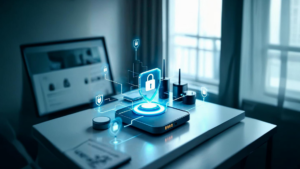

Parthiban Mahendran
5 Minutes read
On-Device AI & Edge Computing in Mobile Apps for the Healthcare Industry
The healthcare industry is undergoing a rapid digital transformation. With the rise of wearables, IoT medical devices, and Electronic Health Records (EHRs), the volume of patient data has exploded. Telemedicine has evolved from a niche offering to a mainstream delivery model, making mobile-first healthcare the new standard of care.
At the same time, data privacy, latency, and cost have become pressing concerns for both providers and patients. Cloud-only AI solutions, while powerful, are often hampered by network delays, connectivity issues, and security risks.
To overcome these challenges, providers are turning to on-device AI and edge computing, which are proving to be game changers.
- On-Device AI: Running machine learning models directly on smartphones, tablets, wearables, and Internet of Medical Things (IoMT) devices. Inference happens locally, ensuring faster response times and greater control over data.
- Edge Computing: Distributing computation closer to where data is generated, such as in hospital gateways, IoT hubs, or smart medical devices, rather than relying solely on remote cloud servers.
Together, they represent a paradigm shift: healthcare intelligence at the point of care, rather than being far away in a data center.
Key Industry Drivers & Challenges
Several forces are accelerating the adoption of on-device AI and edge computing in healthcare, but they come with challenges:
- Regulatory compliance & privacy: Laws like HIPAA (US) and GDPR (EU) mandate strict data protection. Keeping sensitive data local reduces legal risk and simplifies compliance.
- Latency-sensitive use cases: Remote cardiac monitoring, seizure detection, or imaging analysis cannot afford multi-second cloud delays.
- Bandwidth constraints & costs: Streaming high-resolution imaging or continuous sensor data to the cloud is expensive and often impractical.
- Patient adoption: Apps must be reliable, secure, and easy to use to encourage long-term engagement.
- Integration challenges: EHRs and hospital systems often utilize legacy infrastructures, making seamless interoperability a barrier to deployment.
Real-World Use Cases for On-Device AI & Edge in Healthcare Apps
On-device AI has moved far beyond the experimental stage. Today, it is powering practical, life-saving healthcare solutions that operate seamlessly on smartphones, wearables, and edge devices.
- Remote Patient Monitoring
Wearables are increasingly equipped with AI to detect critical conditions such as arrhythmias, glucose fluctuations, and seizure activity — all in real-time. By processing data locally, these devices ensure faster responses and improved patient safety, without depending on cloud connectivity. - Personalized Recommendations
Healthcare apps can now deliver AI-driven insights tailored to each individual. From lifestyle guidance and medication adherence reminders to mental health support, on-device intelligence enables truly personalized care. - Medical Imaging and Diagnostics
AI-enabled scanning applications are making diagnostics faster and more accessible. By analyzing X-rays, ultrasounds, or dermatology images directly on the device, clinicians and patients gain rapid insights at the point of care — even in low-resource or offline settings. - Fall Detection and Emergency Alerts
Healthcare providers are leveraging smartphones and wearable devices for fall detection. Using on-device AI, these devices can automatically trigger emergency alerts to caregivers or healthcare providers, ensuring timely intervention when every second counts. - Drug Adherence Tracking
Computer vision is transforming medication adherence. Using a smartphone camera, AI can verify whether patients are taking their prescribed medications correctly, reducing the risks of missed doses or incorrect usage. - Voice-Based Health Assistants
Finally, conversational Artificial Intelligence (AI) is emerging as a powerful tool for hands-free healthcare support. Voice-based assistants can guide patients through daily health assessments, offer reminders, and even conduct cognitive tests — all while operating securely on the device itself.
Benefits of On-Device AI & Edge for Healthcare
- Data privacy & security: Sensitive health data never leaves the device, reducing the risk of breaches.
- Low latency & real-time insights: Instant feedback in emergencies such as heart attacks or seizures.
- Offline capabilities: Supports reliable operation in rural clinics, remote areas, or disaster zones without connectivity.
- Cost-efficiency: Reduced dependency on expensive cloud infrastructure.
- Personalization & continuous learning: Models can adapt to individual patterns for tailored care.
Technical Enablers & Trends
Multiple technological advances fuel the rise of healthcare on-device AI:
→ Hardware advancements: Neural Processing Units (NPUs) like Apple’s Neural Engine, Qualcomm Hexagon DSP, and Google Edge TPU allow trillions of operations per second on small devices.
→ Frameworks & SDKs: TensorFlow Lite, Core ML, ONNX, PyTorch Mobile, and Qualcomm AI Engine streamline model deployment.
→ Federated learning: Enables model updates across millions of devices without sharing raw patient data.
→ 5G + edge synergy: Combines ultra-low latency networks with localized AI inference for scalable telehealth.
→ TinyML: Ultra-efficient models for wearables and medical IoT devices, optimized for battery life and portability.
Challenges and Considerations
Despite its promise, the adoption of on-device AI faces multiple challenges. Many advanced deep learning models are still too large for mobile deployment, requiring extensive optimization techniques such as pruning and quantization. Continuous inference can drain batteries and create thermal management issues, particularly on smaller wearable devices.
Managing distributed model updates is complex, especially when ensuring regulatory compliance across diverse hardware platforms. Interoperability remains an obstacle, as hospital IT ecosystems often remain fragmented and are resistant to integration with external systems. Additionally, the regulatory burden is significant. AI-driven medical applications may require FDA or CE certification, necessitating rigorous testing, validation, and monitoring throughout the product lifecycle.
Industry Impact & Future Outlook
The next decade will redefine healthcare delivery:
- Hybrid Architectures
Balancing on-device inference for real-time care with cloud-based longitudinal analysis and research. - Personal Health Ecosystems
Integration with Apple Health, Google Fit, and Samsung Health is driving the development of patient-centered digital ecosystems. - AI-Powered Digital Therapeutics
Personalized, evidence-based treatments delivered through mobile apps for chronic conditions and mental health support. - Blockchain Integration
Secure, decentralized health data exchanges combined with AI at the edge enhance privacy and trust. - Autonomous Health Assistants
Always-on, AI-powered digital caregivers embedded in everyday devices provide continuous support.
Recommendations for Healthcare App Builders
To succeed in this evolving space, developers should:
- Adopt a privacy-first design – Treat patient data as local by default.
- Leverage edge inference for urgent tasks – Use the cloud only for longitudinal or large-scale analysis.
- Invest in federated learning – Ensure continuous AI improvement without compromising patient privacy.
- Design for cross-platform interoperability – Support Android, iOS, and wearable ecosystems.
- Build compliance in from the start – Must meet HIPAA, GDPR, and FDA/CE requirements.
- Focus on explainability – Provide transparency in AI-driven recommendations to build trust among clinicians and patients.
Conclusion
On-device AI and edge computing are more than just performance optimizations — they are strategic enablers for the future of healthcare. They offer speed, privacy, and accessibility, while also reducing costs and enabling real-time decisions.
The healthcare industry is moving towards a distributed, privacy-first, patient-centric model, and mobile apps will be at the front line of this transformation. The organizations that embrace this shift will deliver safer, more reliable, and more personalized care, anytime, anywhere.
Related Insights





Artificial Intelligence in Healthcare: Saving Lives and Care

